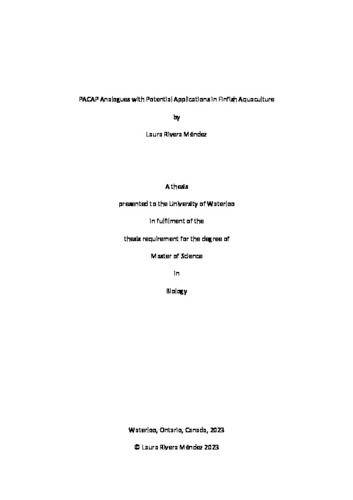| dc.description.abstract | Global aquaculture industry has significant losses each year due to disease outbreaks, parasitic, viral, and bacterial infections. Common methods to treat fish infections include antibiotics, but prolonged use can lead to the emergence of resistant strains. Aeromonas spp. infections are a common and problematic disease in fish, and members of this genera are susceptible to the production of antibiotic resistant strains. Antimicrobial peptides (AMPs) have emerged as an alternative method to treat and prevent infections. Pituitary adenylate cyclase activating polypeptide (PACAP) is a prominent member of this family. PACAP has versatile effects including neural development, anti-tumor activity, metabolism, growth, antimicrobial activity, and modulation of immune responses. Thus, the general objective of this research was to study PACAP direct antimicrobial activity and immunomodulatory effect in rainbow trout cell lines.
Analysis of the experimental results and reviewed literature agree on the direct antimicrobial activity of PACAP on A. salmonicida, A. hydrophila, and Y. ruckeri growth. It was also observed that the direct antimicrobial effects of PACAP is dependent on the culture broth used, but not related with the presence of NaAc in the broth or serine protease secretion. Furthermore, results suggest that PACAP direct antimicrobial activity underlying mechanism include a bacterial membrane permeabilizing effect. This study also demonstrated that the five PACAP variants evaluated showed no toxicity at concentrations lower than 25 μM in vitro and they can be considered safe for using in aquaculture, especially PACAP 1 and 5.
The effect of TNF-α, IL-1β, IL-8, IFNγ, MyD88, and TGFβ cytokine expression on RTgutGC and RTS11 cell lines infected with A.salmonicida and incubated with either PACAP 1 or 5 (200 nM) was evaluated. RT-qPCR results showed that il1b and il8 transcript expression in RTgutGC was significantly downregulated while tgfb expression was upregulated. Importantly, IL-1β and IFNγ protein concentration, was also tested with a significant increase of IFNγ protein levels in the conditioned media of RTS11 cells incubated with PACAP 1 and exposed to A. salmonicida. IL-1β protein concentration was also increased. In general, results showed a poor correlation between gene expression and protein amount, suggesting a stimulation of the translation of IL1-β protein from previously accumulated transcripts.
In-silico studies of PACAP-receptor interactions has also showed a turn of the peptide characteristic of PACAP-PAC 1 interaction, correlated with the higher number of interactions observed with this specific receptor, which is also in agreement with the higher PACAP specificity described for PAC1 compared to VPAC1 and VPACA2. Finally, nine amino acids were selected as most related with the receptor associated PACAP functionality (HIS1, SER2, THR7, ASP8, SER11, ARG12, TYR13, ARG14, TYR22).
The highly conserved sequence of PACAP between species prevents its fast clearance. Furthermore, PACAP stimulates energy metabolism, avoiding antibiotic resistance related to ATP depletion and metabolic collapse. All the results obtained in this thesis also demonstrate that PACAP has a direct antimicrobial effect related to a bacterial membrane permeabilization mechanism, which also reduces the probability of generating resistant bacterial strains. It was also possible to corroborate the immunostimulant properties of PACAP and to identify the amino acids most related to the functionality mediated by its interaction with receptors. The low toxicity also demonstrated in these studies supports the possible oral administration of the peptide. Therefore, PACAP is an environmentally friendly alternative and very promising for use in the aquaculture sector. | en |

